8 April, 2000
LTER Phytoplankton Group; Part 1
Question 49: Has Antarctica always been covered with ice?
This morning, most of Hero Inlet and Arthur Harbor was absolutely packed with
brash ice. There was also a very contented-looking Leopard Seal sitting on a
growler (small iceberg) that I could see out of my bedroom window. It had the
bloody remains of breakfast on the ice next to it. There is so much brash ice
that we can't get the boats out, so no diving today.
When I went out with the two LTER boats in March, the phytoplankton group
operated the first boat I was with. They took water samples at different
depths and measured light intensity (see 3/19 journal entry). The work done
by those on Bruiser focused on the rates of primary production, phytoplankton
community structure and light absorption properties.
Plankton is the term that refers to the small, living organisms which float
in the water. Zooplankton are animal-like organisms, while adding the prefix
"phyto" refines the group to include only the aquatic flora or primary
producers. These, like plants on land, photosynthesize to produce the energy
they need to live. Primary production is the process of creating new material
from the sun's energy. The chemical reaction that the phytoplankton carry
out, photosynthesis, fixes carbon. All other organisms depend, directly or
indirectly, on the energy created by these primary producers. The marine
phytoplankton are single-celled organisms that have chlorophyll. They include
several species of diatoms, dinoflagellates, and other algal groups. They
range in size from 2 um (micrometers) to 20 mm.
Like seasonal land plants, phytoplankton multiply and grow rapidly when
conditions are favorable, then numbers decline. These spurts of growth are
called blooms. They can be grazed down by zooplankton or dispersed by storms
very quickly. How much phytoplankton exists at any given time (biomass)
varies with geographic location, depth, season, and plankton size category.
Because there is a wide range of size in phytoplankton species, scientists
looking at phytoplankton biomass use the concentration of chlorophyll, the
green pigment phytoplankton use to produce food from light, to measure it.
The coastal and fast ice areas of Antarctica tend to have higher
concentrations of chlorophyll than the open water of the Southern Ocean. The
Antarctic Convergence is also an area where high chlorophyll concentrations
have been found routinely. Phytoplankton can be found deep in the ocean as
well as in this phothosynthetic zone. Since they are not fast swimmers, the
mixing water layers and currents in Antarctica can move them around. The
vertical distribution of phytoplankton is important because the deeper they
are in the water, the less light from the surface is available to them.
Phytoplankton can't photosynthesize when they reach depths where less than 1%
of the ambient surface light is available. In some places with more constant
scientific attention, such as McMurdo Station, yearly seasonal blooms have
been identified.
Because of the vast area of the Southern Ocean and the extreme nature of its
seasonal variations, the phytoplankton biomass and production data that has
been taken so far has limitations. More observations, ones that are timed
and located based on plankton biology rather than on schedules and scientific
workload of research vessels, are needed. Year-round observations, especially
in the pack ice zone are lacking due to logistical difficulties. The Palmer
LTER observations are from the limited summer period only.
An additional complication is that all phytoplankton data can't be compared.
Older studies excluded the smaller sizes of phytoplankton which have now been
found to contribute a large percentage of the biomass. The scientific
community is working on identifying patterns of phytoplankton biomass and
production and the factors that cause them. They need more information about
the seasonal progression of primary productivity with latitude, sea state and
wind force data. Also, more needs to be known about the physiology of some
phytoplankton species, zooplankton grazing rates and rates of loss of
phytoplankton cells to sinking and death. These gaps in the data make it
difficult to interpret individual observations, identify trends, or make
generalizations about the phytoplankton of the Southern Ocean. The Palmer
LTER is working to create a solid data set over 10 years in the Palmer area
and along their ocean transects that will mesh with existing data.
Continued 4/10/00...
Answer 48: Antarctica is about 1/10 th of the world's total land surface,
about five and one half million square miles. It is the fifth largest
continent, about the size of the United States (without Alaska) and Mexico
combined. It is mostly covered with ice.
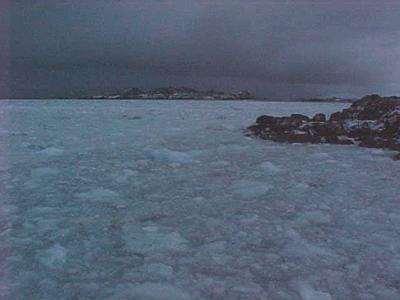
Brash ice extending out to Torgersen Island.
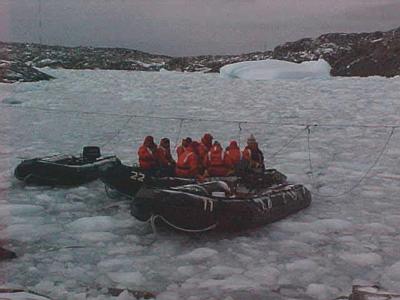
Zodiac stuck at the dock.
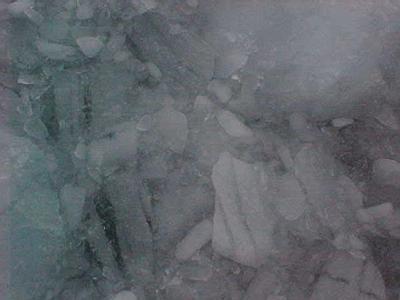
Brash ice up close.
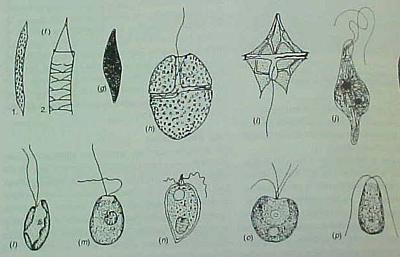


Photomicroscope picture of an ice alga.
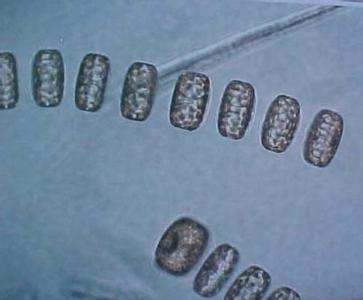
Photomicroscope picture of Thalassiosira, a diatom.

Corethron
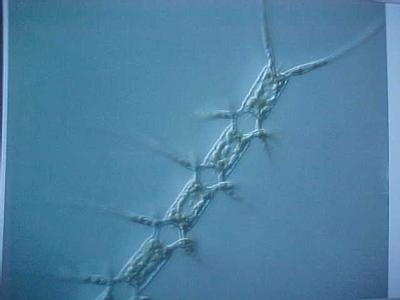
Chaetoceros, a group of diatoms.

Pseudonitzschial, another diatom species.

Contact the TEA in the field at
.
If you cannot connect through your browser, copy the
TEA's e-mail address in the "To:" line of
your favorite e-mail package.
|
